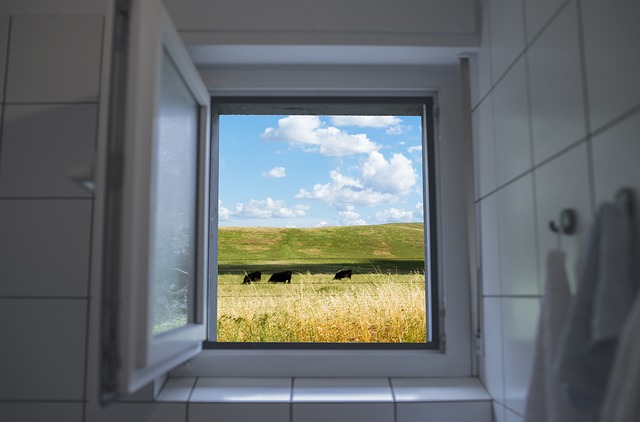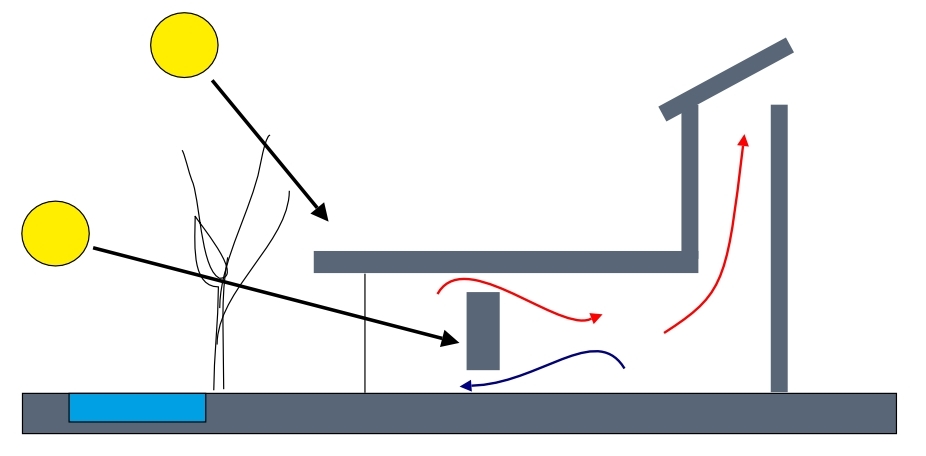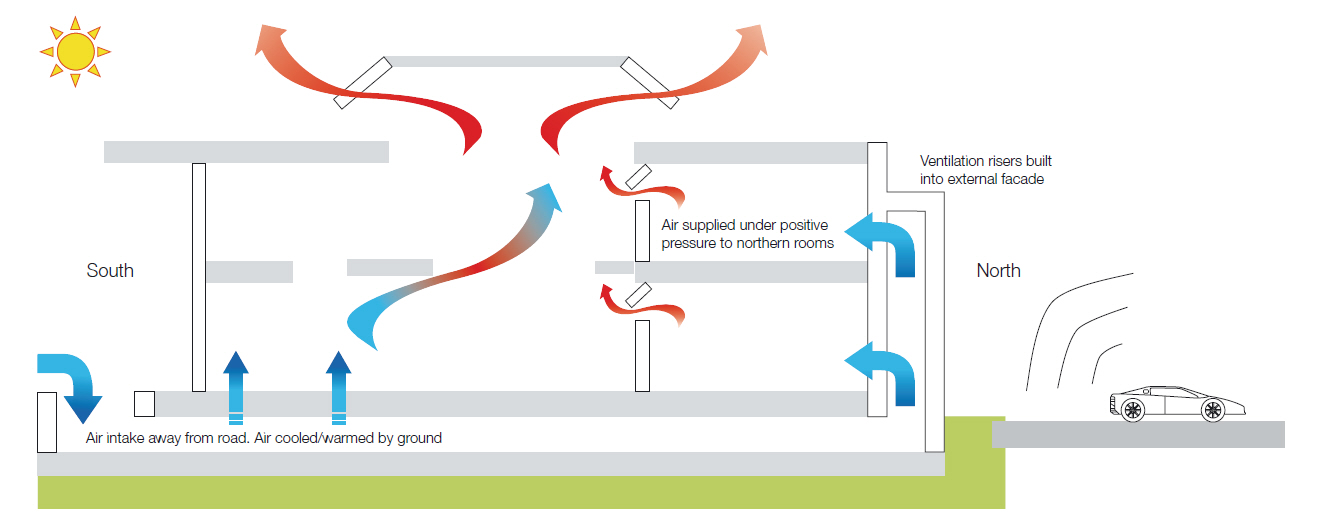Natural ventilation of buildings
Ventilation is necessary in buildings to remove ‘stale’ air and replace it with ‘fresh’ air:
- Helping to moderate internal temperatures.
- Helping to moderate internal humidity.
- Replenishing oxygen.
- Reducing the accumulation of moisture, odours, bacteria, dust, carbon dioxide, smoke and other contaminants that can build up during occupied periods.
- Creating air movement which improves the comfort of occupants.
Contents |
[edit] Brief history
The origins the word ventilation lie in the Latin word ventilatio, or ventulus meaning a breeze, from ventus meaning wind. Ventilatus, was the past participle of ventilare which was interpreted as to brandish, toss in the air, winnow, fan, agitate or set in motion. In early history the roman hypocaust system, was a heated underfloor ventilation system where heated air was distributed through a building via pipes and tile vents. In the early 1630's, King Charles I decreed ceilings in England to be 10 feet (3 meters) and windows taller than their width to allow for natural ventilation as it was assumed poor indoor conditions were causing the nations health problems. By 1660 ventilation was being described as the process of replacing foul air in an enclosed place with fresh, pure air. By the 1740's it was commonly referred to as the act of supplying a room with fresh air, and a blowing wheel system was actually installed in the Houses of Parliament in London. On the side, in slang, ventilation had an adopted meaning of the shoot someone ie by making holes in them, to ventilate them. In the 1840's the Parliament system had been upgraded to a heating and cooling ventilation system, by the early 1900's simple air conditioning systems that started appearing would soon become very commonplace. Whilst from 2000 onwards, with the increasingly awareness of energy conservation, alternative systems with advance natural ventilation, mixed mode and heat recovery continue to become more and more commonplace.
[edit] Natural ventilation approaches
Very broadly, ventilation in buildings can be classified as ‘natural’ or ‘mechanical’
- Mechanical (or forced) ventilation (MV) is driven by fans or other mechanical plant.
- Natural ventilation (NV) is driven by pressure differences between one part of a building and another, or pressure differences between the inside and outside. For more information see Natural ventilation.
Mixed mode (MM), hybrid or assisted ventilation systems, sometimes called intermittent mandatory ventilation (IMV), involve natural ventilation supplemented by mechanical systems to ensure minimal background ventilation, whilst advanced natural ventilation (ANV) is some times used to describe more complex systems that involve certain architecture features such as ventilation stacks, chimneys, shafts or cowls, atria spaces or light wells and wind catchers, cowls or scoops, which may or may not involve some automation.
Natural ventilation tends to cost less to build, operate and maintain than mechanical ventilation, and so this is generally the first option investigated during the design process. However, there may be circumstances where natural ventilation is not possible and so mechanical ventilation is necessary or where advanced natural ventilation systems increase relative costs of natural ventilation strategies as a result of the required inclusion of specific architectural design features.
- The building is too deep to ventilate from the perimeter.
- Local air quality is poor, for example if a building is next to a busy road.
- Local noise levels mean that windows cannot be opened.
- The local urban structure is very dense and shelters the building from the wind.
- Air cooling or air conditioning systems mean that windows cannot be opened.
- Privacy or security requirements prevent windows being opened.
- Internal partitions block air paths.
- The creation of draughts adjacent to openings.
Some of these issues can be avoided or mitigated by careful location, orientation, siting, zoning and design of the building.
Natural ventilation is generally categorised as:
- Wind-driven (or wind-induced) cross ventilation, where pressure differences between one side of the building and the other draw air in on the high pressure side and draw it out on the low pressure side.
- Buoyancy-driven stack ventilation (the stack effect), where cooler air enters the building at low level, is heated by occupants, equipment, heating systems and so on, becomes less dense and so more buoyant and rises through the building to be ventilated to the outside at the top.
The effectiveness of these mechanisms is dependent on a wide number of variables, but very broadly:
- Cross ventilation is suitable for buildings up to approximately 12 to 15m in depth (five times the floor to ceiling height, or 2.5 times the floor to ceiling height if openings can only be provided on one side). Beyond this, providing sufficient fresh air creates draughts close to openings, and additional design elements such as internal courtyards are necessary, or the inclusion of elements such as atrium that combine cross ventilation and stack effects. A disadvantage of cross ventilation is that it tends to be least effective on hot still days, when it is needed most.
- The effectiveness of stack ventilation is influenced by; the effective area of openings, the height of the stack, the temperature difference between the bottom and the top of the stack and pressure differences outside the building. Where ventilation is needed high up in the building, this can require the addition of ventilation stacks that achieve the height necessary to create a pressure difference between the inlets and outlets. See Stack effect for more information.
Combinations of these ventilation strategies, with the additional exploitation of thermal mass can produce a wide range of natural ventilation solutions, such as trombe walls, solar chimneys and so on.
[edit] Advanced natural ventilation approaches
Designing natural ventilation can become extremely complex because of the interaction between cross ventilation and the stack effect as well as complex building geometries and the distribution of openings. This can require analysis using specialist software analysis systems such as computational fluid dynamics.
These more complex natural ventilation systems might be described as advanced natural ventilation (ANV), where strategies go beyond simply bringing fresh air into and extracting stale air out of buildings, via single sided or cross ventilated opening lights, windows or trickle ventilators. Advanced natural ventilation (ANV) describes strategies that might include specific architectural features to promote natural ventilation through stack effect, buoyancy or wind driven ventilation such as ventilation stacks, chimneys, shafts or cowls, atria spaces or light wells and wind catchers, cowls or scoops, sometimes involving automation.
It can sometimes be beneficial to automate natural ventilation systems, or to provide training for occupants and monitor behaviour to ensure systems continue to be operated as intended because natural ventilation is also influenced by occupant behaviour. As an example a person near to a window may choose to close it because of close proximity drafts, which might impact the level of carbon dioxide in the whole room by reducing the ventilation, which can in turn impact performance of others in the workplace.
However from the other perspective over automation of ventilation systems can leave occupants feeling disempowered, and unable to locally influence the conditions around them (for example by opening or closing a window themself) as a result this can have the consequence that they are more likely to express dissatisfaction with the overall internal conditions and environment they find themselves. In some cases even if the internal environment is in fact optimal when measure empirically.
In modern buildings, which tend to be designed to be completely sealed from the outside unless windows or other ventilators are open, problems, such as condensation, can occur during the winter when openings are closed. As a result, ‘trickle ventilation’, or 'background' ventilation tends to be provided to ensure there is always an adequate level of ventilation. Trickle ventilators can be self-balancing, with the size of the open area depending on the air pressure difference across it.
It is possible, although relatively complicated to include heat recovery in natural ventilation systems so that during cooler conditions, heat recovered from extract air is used to pre-heat fresh air entering the building. These systems are normally referred to as mechanical ventilation heat recovery or MVHR, and are a integral part of design strategies such as the Passivhaus standard, along with high levels of airtightness, insulation and high performing glazing. These elements combined can help to dramatically reduce the heat energy require in a space, they can also help reduce the surface temperature differential between for example glazed surfaces and solid surfaces which can help improve comfort leves near those surfaces such as for example a desk placed next to a window, during colder winter months.
In addition, thermal mass can be used to pre-heat supply air. For example, see Thermal Labyrinth and Ground preconditioning of supply air.
Ventilation in buildings is regulated by Part F of the building regulations. Approved document F includes standards for ventilation and air quality for all buildings and requirements for the prevention of condensation. The types of ventilation covered include; mechanical, passive stack, background and purge (rapid). In the 2021 revision, Approved Document F was been split into two volumes, with Volume 1 relating to dwellings, and Volume 2 for non-dwellings. The Domestic Ventilation Compliance Guide was also amalgamated into the document for ease of understanding and use.
Approved Document F Volume 1, 2021 edition, defines natural ventilation as: 'Ventilation provided by thermal, wind or diffusion effects through doors, windows or other intentional openings without the use of mechanically driven equipment. For the purposes of this approved document, a natural ventilation strategy may include decentralised
extract ventilation from rooms where water vapour or pollutants are likely to be released to minimise their spread to the rest of the building.'
See Approved document F for more information.
[edit] Related articles on Designing Buildings
- Airbrick.
- BREEAM Potential for natural ventilation.
- Changes to Building Regulations Part F.
- Chilled beam.
- Complex system.
- Condensation.
- Convection.
- Cross ventilation.
- Dew point.
- Heat gain.
- Humidity.
- Interstitial condensation.
- Mechanical, electrical and plumbing MEP.
- Mechanical ventilation.
- Mixed-mode ventilation.
- Night-time purging.
- Passive building design.
- Passive solar design.
- Single-sided ventilation.
- Solar chimney
- Stack effect
- Sustainability.
- Thermal mass
- Trombe walls.
- Types of ventilation.
- Ventilation.
- Windcatcher.
Featured articles and news
Infrastructure that connect the physical and digital domains.
Harnessing robotics and AI in challenging environments
The key to nuclear decommissioning and fusion engineering.
BSRIA announces Lisa Ashworth as new CEO
Tasked with furthering BSRIA’s impressive growth ambitions.
Public buildings get half a million energy efficiency boost
£557 million to switch to cleaner heating and save on energy.
CIOB launches pre-election manifesto
Outlining potential future policies for the next government.
Grenfell Tower Inquiry announcement
Phase 2 hearings come to a close and the final report due in September.
Progress from Parts L, F and O: A whitepaper, one year on.
A replicated study to understand the opinion of practitioners.
ECA announces new president 2024
Electrical engineer and business leader Stuart Smith.
A distinct type of countryside that should be celebrated.
Should Part O be extended to existing buildings?
EAC brands heatwave adaptation a missed opportunity.
Definition of Statutory in workplace and facilities management
Established by IWFM, BESA, CIBSE and BSRIA.
Tackling the transition from traditional heating systems
59% lack the necessary information and confidence to switch.
The general election and the construction industry
As PM, Rishi Sunak announces July 4 date for an election.
Eco apprenticeships continue help grow green workforce
A year after being recognised at the King's coronation.
Permitted development rights for agricultural buildings
The changes coming into effect as of May 21, 2024.

























